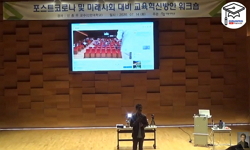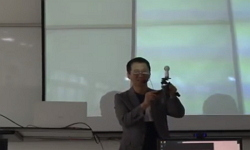Ⅰ. 사업의 배경 및 추진체계 ❏ 사업 배경 및 목적 ㅇ 동아시아 지역은 동일한 환경영향권 내에서 공동의 환경문제를 공유하고 있어 지역차원의 환경협력이 필수적임 ㅇ 우리나라는 국제사...
http://chineseinput.net/에서 pinyin(병음)방식으로 중국어를 변환할 수 있습니다.
변환된 중국어를 복사하여 사용하시면 됩니다.
- 中文 을 입력하시려면 zhongwen을 입력하시고 space를누르시면됩니다.
- 北京 을 입력하시려면 beijing을 입력하시고 space를 누르시면 됩니다.
동아시아 환경공동체 발전전략 개발 및 협력사업 = Development Strategy and Partnership Projects for Environmental Community in East Asia
한글로보기https://www.riss.kr/link?id=A107374794
- 저자
- 발행기관
- 학술지명
- 권호사항
-
발행연도
2020
-
작성언어
-
- 주제어
-
자료형태
학술저널
-
수록면
1-283(283쪽)
- 제공처
-
0
상세조회 -
0
다운로드
부가정보
국문 초록 (Abstract)
Ⅰ. 사업의 배경 및 추진체계
❏ 사업 배경 및 목적
ㅇ 동아시아 지역은 동일한 환경영향권 내에서 공동의 환경문제를 공유하고 있어 지역차원의 환경협력이 필수적임
ㅇ 우리나라는 국제사회에서 전 지구적 환경문제 해결을 위한 노력에 동참하고, 동아시아 국가 간 환경협력 강화를 정책의 기조로 하고 있음
ㅇ 본 사업은 동아시아 환경협력을 위한 네트워크를 구축하여 국가별 환경정보 및 정책정보를 공유하고, 환경공동체 인식을 확산하여 지속가능한 발전 실현을 위한 협력체계 구축에 기여하고자 함
❏ 사업 내용
ㅇ 본 사업은 동아시아 지역 환경 상태 및 정책에 대한 분석을 기반으로 동아시아 환경협력 전략 개발을 위한 연구·조사 활동과 환경공동체 인식 확산을 위한 국내외 네트워크활동 및 정보공유 활동으로 구성되어 있음
Ⅱ. 네트워크 구축 및 운영
1. 국내 네트워크
❏ 중국환경포럼
ㅇ 중국 일대일로 정책과 한국 신북방정책의 연계 협력방안 및 환경 분야 협력전략 모색에 관해 두 차례에 걸쳐 중국환경포럼을 운영함
❏ 남방환경포럼
ㅇ 신남방정책의 환경 분야 추진계획 이행을 위한 한국과 아세안 국가들의 협력 수요를 모색 및 확대하기 위하여 두 차례에 걸쳐 남방환경포럼을 운영함
2. 국제 네트워크 활동
❏ 한·중·일 포스트 코로나 시대 환경협력 전문가 워크숍
ㅇ 포스트 코로나 시대 한·중·일 환경 이슈와 국제협력에 대하여 전문가 워크숍을 온·오프라인으로 동시 진행함
❏ 2020 KEI-VASS-RAC-LASS 공동세미나
ㅇ 2012년부터 매년 베트남사회과학원(VASS), 캄보디아왕립학회(RAC), 라오스사회과학원(LASS)과 동남아지역 지속가능발전 및 녹색성장을 위한 지식공유 세미나를 개최하여 왔으나, 올해는 코로나19로 개최하지 못하였음
※ 본 공동세미나는 2020년 11월 26~27일 캄보디아 프놈펜에서 ‘Smart Cities in the Mekong Region’을 주제로 개최될 예정이었음
Ⅲ. 포스트 코로나시대 동북아 국가의 환경정책 및 국제협력
ㅇ 코로나19 대유행으로 전 세계 각국은 대기, 에너지, 폐기물 등과 관련한 각종 환경이슈를 직면하게 됨
ㅇ 한·중·일 코로나19 관련 환경 이슈와 대책을 살펴보고, 포스트 코로나 시대 주요환경정책 변화와 국제협력 방향을 모색하고자 함
1. 한국의 포스트 코로나 시대 환경정책
❏ 한국의 코로나19 관련 주요 환경 이슈
ㅇ 2020년 상반기 에너지 소비 감소
- 산업, 수송, 상업, 공공 부문은 감소하였으나, 가정 부문은 증가
ㅇ 교통량 감소
- 항공 운항 편수 및 여객 수 급감
- 고속도로 교통량 감소
ㅇ 가정 내 생활시간 및 활동 증가
- 전국 택배 물동량 전년도 상반기 대비 증가
- 온라인 음식서비스 거래액 전년도 상반기 대비 급증
- 서울시 1인 가정용수 사용량 전년도 상반기 대비 증가
ㅇ 대기환경 개선
- 대기질 전반적으로 개선
※ 대기환경은 복합적인 원인이 있을 수 있어 장기적 검토 필요
ㅇ 의료폐기물
- 코로나19 관련 격리의료폐기물이 증가하였으나 일반의료폐기물이 감소하여 전체 폐기물 발생량은 안정적임
ㅇ 야생동물
- 해외 유입 야생동물이 감염병의 숙주 역할 가능성이 있어 관련 관리가 이슈가 됨
ㅇ 플라스틱 폐기물
- 전년도 상반기 대비 폐비닐 11.1%, 플라스틱 15.25% 증가
- 재활용 처리장의 과부하 문제 및 폐플라스틱 가격 하락
❏ 한국의 코로나19 대응 주요 환경대책
ㅇ 의료폐기물 관리
- 1월 말 ‘신종 코로나바이러스감염증 관련 폐기물 안전 관리 특별대책’ 제1판, 2월 말 제2판, 3월 초 제3판 발표
- 기존 의료폐기물 8종 분류체계를 코로나19를 포함한 9종으로 확대
- 의료폐기물 전용용기의 원활한 공급을 위한 규정 완화
ㅇ 야생동물
- 4월 말 ‘외래생물 관리 종합대응 지침서’ 발간 및 배포
- 5월 개정된 「야생생물 보호 및 관리에 관한 법률 시행령」 시행
ㅇ 플라스틱 폐기물
- 재활용산업 기업 자금 유동성 지원 조치
- 페트 재생원료 공공비축 조치 및 ‘재활용시장 코로나 대응 콜센터’ 운영
❏ 포스트 코로나 시대 한국 환경정책의 발전방향
ㅇ 코로나19로 인한 경제위기와 기후·환경위기를 동시에 극복하는 전략으로 7월 ‘그린뉴딜’ 정책 발표
- 저탄소 경제·사회 생태계 지향 3대 분야 8대 추진과제
2. 중국의 포스트 코로나 시대 환경정책
❏ 중국의 코로나19 관련 주요 환경 이슈
ㅇ 에너지 사용량 감소
- 산업용 전력사용량 감소, 가정용 전력사용량 증가
ㅇ 교통량 감소
- 도로 여객 수송량 전년도 동기 대비 급감
ㅇ 의료폐기물 증가
- 주요 방역대상 지역 의료폐기물 배출량 50% 이상 증가
ㅇ 대기환경 개선
- 전력사용량과 교통량이 감소하면서 대기오염물질 배출량과 오염도 저감 효과 유발
ㅇ 수질 개선
- 사회·경제 활동 제한으로 수질오염물질의 배출량 또한 감소하면서 수질 개선
ㅇ 야생동물
- 코로나19의 발병 원인이 중국의 야생동물 식용과 거래로 지목됨에 따라 대중 인식변화 및 각계 전문가와 사회단체들 야생동물 식용 비판 및 규제 강화 요구
- 일부 양식종은 빈곤층의 중요 소득원으로 농가에 상당한 타격 예상
ㅇ 환경산업 운영비용 증가
- 시장 공급량 감소로 오수처리장 운영에 필요한 화학약품 원자재 가격이 급등
❏ 중국의 코로나19 대응 주요 환경대책
ㅇ 의료폐기물 급증으로 이동형 폐기물 처리시설 가동 및 타 도시로 운송하여 처리
ㅇ 산업계에 환경보호 규제방법을 전환
- 더욱 엄격한 책임 추궁제, 녹색금융대출 및 세금혜택, 사회영향 동원
ㅇ 코로나19로 인해 환경규제가 느슨해지지는 않을 것이며, 지역별로 차별화되고 과학적인 환경규제를 도입
ㅇ 오수처리 업체 및 환경기업, 녹색금융 및 세수 정책으로 운영 지원
ㅇ 재정역량 부족한 지방정부는 재정지원으로 환경영향을 저감하도록 협조 조치
❏ 포스트 코로나 시대 중국 환경정책의 발전방향
ㅇ 생태환경 보호 발전방향 유지, 추진력 강화
ㅇ 과학적이고 정확한 오염 관리
ㅇ 에너지, 산업 등 구조조정 가속화
ㅇ 중앙환경보호감찰 2기 사업 실시
ㅇ 경제성장 지원을 위한 환경보호 정책 최적화
3. 일본의 포스트 코로나 시대 환경정책
❏ 일본의 코로나19 관련 주요 환경 이슈
ㅇ 교통량 및 운송량
- 상업용 화물차 운송량 및 연료 사용량 감소, 항공 화물 운송량 전년 대비 급감
- 여객 이동량 및 도로 이용 연료 사용량, 철도 승객수, 항공 승객수 전년 대비 급감
- 철도는 화물운송 시행으로 수익 개선 도모하고, 택시업계는 음식배달 및 쇼핑대행업계와 연계하여 사업다각화 진행
ㅇ 대기환경 개선
- 도쿄 주변 CO2 농도 감소
ㅇ 폐기물 배출량
- 도쿄시 가정쓰레기 발생량 증가, 상업용 쓰레기 감소
- (도쿄, 요코하마, 오사카) 가정 플라스틱 배출량 전년 동기 대비 증가
ㅇ 상업용 물 사용량 감소
❏ 포스트 코로나 시대 일본 환경정책의 발전방향
ㅇ 환경개발 및 보존, 양립을 위한 녹색 부흥 강조
ㅇ 환경보호 인간행동 및 인식변화 등의 소프트웨어적 접근
4. 포스트 코로나 시대 동북아지역 환경협력 강화 방안
❏ 한·중·일 코로나19 관련 환경 이슈, 대응, 향후 환경정책 방향 비교
ㅇ 3국 모두 대기질이 개선되었지만 의료폐기물과 플라스틱 폐기물 증가
ㅇ 한국에서는 플라스틱 관련 이슈, 중국에서는 야생동물 식용과 거래 관련 이슈, 일본에서는 철도업계와 택시업계의 사업다각화 이슈가 부각됨
ㅇ 3국 모두 의료폐기물 관리 대책을 발표하여 대응함
ㅇ 한국에서는 재활용산업 지원책, 중국에서는 기업 활동이 위축되지 않도록 환경규제 완화 및 기업서비스 지원책, 일본에서는 기술 개발 및 국민 대상 홍보가 부각됨
ㅇ 3국은 모두 향후 환경 및 사회경제 전반에 걸친 녹색 발전을 강조함
ㅇ 한국은 그린뉴딜정책, 중국은 과학적인 환경관리 및 엄격한 책임제, 일본은 국민의 인식 및 행동 변화에 주력함
❏ 주요 협력 분야
ㅇ 녹색전환, 녹색회복 정책과 기술 정보 교환 및 협력프로젝트 추진
ㅇ 비대면 기술과 디지털 기술을 활용한 환경모니터링 및 환경관리 정보 공유와 기술협력 강화, 비대면 대화 플랫폼 구축
ㅇ 의료폐기물 및 기타 감염성 폐기물, 플라스틱 폐기물의 안전한 처리 및 관리 정보, 기술 및 정책 경험 공유, 협력사업 확대
ㅇ 인수공통감염병 예방과 생물다양성 서식지 보호와 복원 협력 대폭 강화
Ⅳ. 재중 한국기업의 환경규제 대응현황조사
1. 조사 개요
❏ 조사 목적 및 설계
ㅇ 중국 정부의 환경규제 강화에 대하여 재중 한국기업의 인식 및 대응 현황을 진단하고 정책적 시사점을 도출하고 대응방안을 마련하기 위한 기초자료를 구축하고자 함
2. 조사 결과
ㅇ 중국의 환경규제가 기업경영에 미치는 영향이 많다는 인식이 높고 규제와 직접 관련된 환경 분야는 대기, 폐기물, 화학물질, 물, 토양 순이었음
ㅇ 환경규제에 대하여 우리 기업은 환경설비·생산설비 개선과 같은 하드웨어적인 측면, 그리고 중국 관계 당국과 소통을 강화하고 관련된 정보 네트워크를 구축하는 등의 소프트웨어적인 측면에서 대응하고 있음
ㅇ 우리 기업 대부분은 중국 환경규제에 대한 정보를 중국 정부 기관을 통해 직접 획득하고 있음
ㅇ 한국 기관은 기업의 수요에 맞는 정보를 신속, 정확하고 이해가 용이하게 제공하도록 노력할 필요가 있음
Ⅴ. 동아시아 지역 환경문제에 대한 국민인식조사
1. 조사 개요
❏ 조사 목적 및 설계
ㅇ 동아시아 지역 환경문제의 원인과 해결방법에 대한 공통된 인식을 바탕으로 협력전략을 모색하고자 함
2. 조사 결과
ㅇ 환경과 국제환경협력에 대한 인식
- 우리 국민의 환경에 대한 관심도는 상당히 높으나 환경에 대한 관심 수준과 인지 정도 사이에는 격차를 보임
- 실제 친환경 행동에 반영되는 정도는 비교적 높다고 할 수 있으며, 환경에 관한 한 인지부조화 정도는 비교적 낮다고 볼 수 있음
- 국민 상당수가 TV나 언론기사를 통해 환경문제 정보를 접하고 있어 향후 관련기관들이 환경정보 제공을 위해 우선해야 할 매체에 대한 시사점을 제공
- 개도국의 환경 분야에 무상원조를 해야 하는 이유로 초국가적 문제 해결 필요성을 우선시하고 있음
ㅇ 동북아시아 환경문제에 대한 인식
- 동북아시아 지역의 가장 심각한 환경문제 및 난제로 기후변화와 대기오염을 선택하였고, 정부가 정치·외교 관계 개선을 바탕으로 공식적 협정 및 조약 등을 통해 지역 및 국제 환경문제를 해결하는 방식을 선호함
ㅇ 동남아시아 환경문제에 대한 인식
- 동북아시아 환경문제에 대한 인식과 비교해보면 기후변화, 대기오염의 비중이 작고 자연훼손의 비중이 큼
- 우리 국민은 대기오염과 기후변화를 아시아 공통 환경 이슈로 인식하고 있고, 동남아시아 지역 환경 현안을 비교적 잘 이해하고 있음
- 기술 및 산업컨설팅 방식의 협력을 가장 많이 선택하였고, 베트남, 인도네시아, 필리핀, 태국 등의 순으로 우선 협력 대상국을 선택하였는데, 다양한 차원에서의 국익을 관련지어 고려함을 알 수 있음
Ⅵ. 동아시아 주요국과의 환경협력 전략 모색
1. 중국의 일대일로와 일본·인도의 아시아-아프리카 성장회랑 비교
ㅇ 중국의 일대일로
- 중국의 일대일로가 지속가능발전목표에 부합하고 녹색성장을 도모하기 위해서는 에너지 분야 점유율 선점을 위한 노력 필요
- 재정 조달, 환경 및 도덕성 등 국제적 비판 및 리스크가 있지만 향후 지속적으로 추진할 것으로 예상됨
ㅇ 일본·인도의 아시아-아프리카 성장회랑
- 일본과 인도의 글로벌 파트너십 구축은 중국의 부상에 균형을 맞추기 위한 양국의 외교정책이자 전략적 선택임
- 환경친화성을 강조하고 중국의 일대일로 정책과 차별성을 추구하고 있음
2. 신남방정책과 환경협력
ㅇ 우리나라와 아세안 환경협력
- 강점: 중국에 비해 우호적 여론, 2위 교역 파트너, 3위 투자지역, ODA 경험 우위
- 약점: 한·아세안 환경협력 조직 및 중장기 전략 부재, 작은 규모의 지원, 아세안개별 국가와의 협력채널 부족
- 기회요인: 중국시장 대체 생산 및 소비거점 부상, 한·아세안 자유무역협정체결, 아세안 경제사회공동체 역내통합 노력 지속, 한국 인지도·선호도 제고
- 위협요인: 중국 등 아세안 진출 확대로 경쟁 심화, 일부 국가 정치적 불안정, 아세안국가들의 거버넌스 역량 부족
Ⅶ. 국내외 환경정보 전파
❏ 「중국환경브리프」 발간
ㅇ 최신의 중국환경 현황 및 정책 자료를 정부 부처 및 관련 기관, 전문가 등에 제공하기 위하여 분기별 및 특별호를 발간함
❏ 「Environmental Sustainability in Asia」 발간
ㅇ 베트남사회교육원(VASS), 자원환경전략정책연구소(ISPONRE)와 스마트시티, 기후변화, 생태산업단지를 주제로 ESA를 발간하여 환경 분야 연구협력 기반을 강화함
❏ 동아시아 우수 환경정책 온라인 교육콘텐츠 개발 및 운영
ㅇ KEI-VASS-RAC-LASS 공동세미나 사전 정보교류 및 주요 파트너 국가 대상 역량강화를 목적으로 스마트시티를 주제로 4차시 콘텐츠 개발 및 운영
다국어 초록 (Multilingual Abstract)
Ⅰ. Background and Aims of Research ❏ Background and purpose ㅇ Being located within the same environmental impact zone, East Asian countries face common environmental issues. It is thus essential to deal with these problems in a cooperative manne...
Ⅰ. Background and Aims of Research
❏ Background and purpose
ㅇ Being located within the same environmental impact zone, East Asian countries face common environmental issues. It is thus essential to deal with these problems in a cooperative manner
ㅇ South Korea is an active participant in international efforts to resolve global environmental issues; strengthening regional environmental cooperation is a keystone of its environmental policy
ㅇ The purpose of this project is twofold: First, to build a network for East Asian environmental cooperation through which member states are able to share environmental and policy information. Second, to contribute to the establishment of a system for realizing sustainable development by spreading awareness of environmental communities
❏ Project synopsis
ㅇ Based on analyses of environmental conditions and policies in East Asia, this project comprises two core activities. The first is the development of environmental cooperation strategies for East Asia through desk research and the conduct of surveys. The second consists of a group of tasks that revolve around domestic and international networking and information-sharing activities to spread awareness of environmental communities
Ⅱ. Establishment and Operation of Environmental Networks
1. Domestic networking activities
ㅇ Two Chinese Environment forums were held to devise collaborative environmental strategies and establish cooperative linkages between China’s One Belt, One Road policy and Korea’s New Northern Policy
ㅇ Two Southeast Asian Environment forums were held to both carry out the environmental initiatives of Korea’s New Southern Policy and to seek out and expand demand for environmental cooperation among the member states of the Association of Southeast Asian Nations (ASEAN)
2. International networking activities
ㅇ A trilateral online/offline blended workshop was held with experts from Korea, Japan, and China on environmental issues and international cooperation in the post-COVID-19 era
ㅇ Annually since 2012, the Korean Environment Institute (KEI), the Vietnam Academy of Social Sciences (VASS), the Royal Academy of Cambodia (RAC) and the Lao Academy of Social Sciences (LASS) have held a joint seminar to share knowledge on sustainable development and green growth in South Asia; the event was canceled in 2020 on account of the COVID-19 pandemic
Ⅲ. Environmental Policies and International Cooperation in Northeast Asia after the COVID-19 Pandemic
ㅇ Examining environmental issues related to COVID-19 and policy responses in Korea, Japan and China and exploring major environmental changes and directions for international cooperation post-pandemic
1. Post-pandemic environmental policies in Korea
❏ COVID-19 environmental issues
ㅇ Reduced energy consumption in H1 2020 YOY
- Overall year-over-year fall in electricity consumption
ㅇ Reduced transportation levels
- Both number of flights and passengers loads severely diminished
- Diminished traffic flows on domestic expressways
ㅇ Growth in homebound economic activity
- Package deliveries up in H1 2020 YOY
- Significant increase in value of online food orders in H1 2020 YOY
- Per capita water consumption Seoul also up YOY for H1 2020
ㅇ Atmospheric recovery
- Overall, notable improvements to atmospheric conditions
※ Changes in atmospheric conditions have complex causes and require a longitudinal review
ㅇ Medical waste
- There has been an increase in contaminated medical waste related to the COVID-19 pandemic. This has coincided with a reduction in general medical waste; proper handling and disposal of both types of waste a key policy issue going forward
ㅇ Wildlife
- Animals either migrating into the country or brought it from abroad may be carriers of infectious diseases, posing management challenges
ㅇ Plastic waste
- Vinyl waste up 11.1% in H1 2020 YOY; plastic waste up 15.25% in H1 2020 YOY
- Recycling centers are over capacity and low prices for waste plastic
❏ Environmental policies in Korea’s response to the COVID-19 pandemic
ㅇ Medical waste management policies
- The government issued its first directives for the safe disposal of coronavirus-related medical waste at the end of January 2020. This guidance was updated twice more, once at the end of February and again at the beginning of March.
- The medical waste classification system was expanded, from eight to nine types, reflecting addition of coronavirus-contaminated waste
- Reforms were made to regulatory regime designed to ensure steady supply of biohazard containers for medical waste
ㅇ Wildlife management policies
- Comprehensive guidelines on the management of invasive species were published and distributed to relevant agencies at the end of April 2020
- Enforced ordinance on Wildlife Protection and Management Act as amended in May 2020
ㅇ Plastic waste policies
- Measures aimed at keeping recycling firms liquid were instituted to help mitigate the impacts of the pandemic
- Execution of a government-led initiative to prop up prices for plastic waste by buying and selling at market rates. This accompanied the operation of a call center to provide consultation on COVID-19 response
❏ Post-pandemic environmental policies in Korea
ㅇ Promulgation of the Green New Deal in July, a package of policies and measures to overcome environmental, climate and economic crises related to the COVID-19 pandemic
- Eight policy tasks in three fields working toward a low-carbon socioeconomic ecosystem
2. Post-pandemic environmental policies in China
❏ COVID-19 environmental issues
ㅇ Reductions in energy use
- Industrial electricity use level fell while domestic use grew
ㅇ Falling transit volumes
- Road passenger traffic plunged YOY
ㅇ Increase in medical waste
- Volumes of daily medical waste skyrocketed
- In areas hard it by the virus subject to special control and containment, medical waste volumes surged by 50%
ㅇ Atmospheric recovery
- Notable reduction in pollution levels and emissions owing to reduced energy consumption and decreased emissions in transportation sector
ㅇ Improvements in water quality
- Water quality improved markedly as limitations on social and economic activity led to reductions in waterborne pollutants
ㅇ Wildlife
- Civil society and experts have criticized the trade in wildlife at China’s so-called “wet markets,” calling for reform as the origins of the novel coronavirus became public knowledge
- Controls on wet markets likely to come as a blow to low-income groups dependent on the trade of certain species
ㅇ Rising costs in environment-related industries
- Shutdowns in production facilities led to a supply shortage and soaring prices for chemicals used in wastewater treatment.
❏ Environmental policies in China’s response to the COVID-19 pandemic
ㅇ Massive new volumes of medical waste prompted the mobilization of roving medical waste disposal facilities capable of disposing of or transporting contaminated waste elsewhere for safe disposal
ㅇ Transformation of environmental regulatory regime in industry
ㅇ Introduction of regionally-specific, science-based environmental regulations
ㅇ Green finance and tax-support programs put in place for environmental and wastewater treatment firms
ㅇ Implementation of cooperative measures to help local governments with weak finances work with other local governments to reduce environmental impacts
❏ Post-pandemic environmental policies in China
ㅇ Maintain focus on ecosystem protection in development plans; strengthen driving initiative
ㅇ Scientific and accurate management of pollution
ㅇ Accelerate restructuring in energy and industrial structure
ㅇ Carry out 2nd phase of Central Environmental Protection Inspection project
ㅇ Optimize environmental protection policies to support economic growth
3. Post-pandemic environmental policies in Japan
❏ COVID-19 environmental issues
ㅇ Transportation and shipping volumes
- Fuel consumption of commercial freight trucks down; sharp reduction in air shipments YOY
- Passenger transit volumes down; fuel consumption on roadways down; significant drops in rail and air passenger volume YOY
- Railways hoping to improve profits through freight shipments; taxi industry diversifying with linkages to food delivery and designated shopping services
ㅇ Atmospheric recovery
- Decline in atmospheric carbon dioxide levels in greater Tokyo
ㅇ Waste production volume
- Increased production of household waste in Tokyo proper; fall in waste production at commercial sites resulted in overall reduction in YOY monthly waste production
- Household plastic waste volumes in Tokyo, Yokohama and Osaka up over the same period YOY
ㅇ Reduction in commercial water withdrawals
- Major drop in commercial water use recorded in city of Nagahama
❏ Post-pandemic environmental policies in Japan
ㅇ Emphasis on a green revival to support the coexistence of environmental development and preservation
ㅇ Utilization of a “software” approach, which seeks to change human behavior and thinking
4. Measures to strengthen post-pandemic environmental cooperation in Northeast Asia
❏ Comparing COVID-19 environmental issues, responses and policy directions in Korea, China and Japan
ㅇ All three countries noted improvements in atmospheric quality and increases in medical and plastic waste
ㅇ The plastic problem is the standout issue in Korea, the wildlife trade and consumption of bush meat issue in China, and tribulations of the taxi and rail industries issue is in Japan
ㅇ All three countries promulgated and implemented policies to manage the medical waste problem
ㅇ Standout measures include the support policies for recycling firms in Korea, the efforts by the Chinese government to boost corporate activity through environmental deregulation and government support services and the technological development and public relations blitz in Japan
ㅇ All three countries emphasize green development across the economy and environment
ㅇ In Korea this is represented by the Green New Deal; in China, by science
-based environmental management and a strict liability system and in Japan, through measures to influence public thought and behavior
❏ Principal areas for potential cooperation
ㅇ Cooperation in the green transition, focusing on green recovery policies and technological exchange
ㅇ Cooperating through the sharing of environmental information in monitoring and management using remote communication and digital technologies; strengthened cooperation in technology and the establishment of a remote platform for dialogue
ㅇ Expansion of cooperation through the exchange of technology and lessons learned; sharing of information on the safe disposal and management of plastic waste; exchange of knowledge on the handling of medical waste and biohazards
ㅇ Broad-based expansion of cooperative activity in biodiversity protection and restoration of wildlife habitats; collaborative efforts in preventing spread of zoonotic viruses and diseases
Ⅳ. Survey of China-based Korean Firms’ Responses to Environmental Regulation
1. Overview and purpose
ㅇ Purpose: to gather basic data on Korean firms in China with regards to the Chinese government’s tightening of environmental regulations. These data will be used to diagnose Korean firms’ perceptions of and responses to the new regulatory regime, from which implications for policy may be derived and contingency plans built
ㅇ Survey method: an online survey was conducted from September to October of 2020 targeting 300 Korean firms in China, with a confidence level of 95% and a margin of error of plus or minus 5.4%p. Survey firm: Beijing Idea Cube Consulting, Ltd.
2. Results
ㅇ Overall, the survey found that Korean executives felt the new regulations had a considerable effect on daily business operations. The regulations were seen to most directly affect, by order of severity, the management of air, waste, chemicals, water and soil issues
ㅇ Korean firms are responding to the tightened regulations by upgrading both “hardware” and “software.” The hardware upgrades include compliance improvements to environmental and production facilities. The upgrades to the software constitute strengthening communication channels with relevant Chinese authorities and establishing information networks
ㅇ Most Korean firms in China obtain information on environmental regulations directly from Chinese government agencies
ㅇ Korean government agencies need to make efforts to provide accurate and easily-digestible information to Korean firms
Ⅴ. Survey of National Perception toward Environmental Problems in East Asia
1. Overview and purpose
ㅇ Purpose: to seek out cooperation strategies for dealing with the root causes of environmental problems in East Asia based on common understandings
ㅇ Survey method: an online panel survey of 1,000 adults was conducted from September 3<sup>rd</sup> to September 15<sup>th</sup> at the 95% confidence level with a margin of error of plus or minus 3.1%p. Survey firm: Research and Research, Inc.
2. Results
ㅇ Environmental awareness and international cooperation on environmental issues
- The survey results suggests that Koreans are deeply interested in environmental issues, but that there is a gap between the level of interest and the level of understanding
- Koreans exhibit a fairly high degree of eco-friendly behaviors in daily life and a relatively low level of cognitive dissonance
- A large number of people are exposed to environmental issues through television programs or news reports. Relevant government agencies should keep this in mind when deciding how to communicate environmental information
- Solving transnational environmental issues is seen as a reason to provide aid to developing countries
ㅇ Perception of environmental problems in Northeast Asia
- Global warming and air pollution were identified as the most severe environmental problems in Northeast Asia. The government is seen to prefer handling environmental problems through formal diplomatic agreements or treaties
ㅇ Perception of environmental problems in Southeast Asia
- While a greater proportion of respondents saw climate change as a major environmental challenge in Northeast Asia, in Southeast Asia, more respondents saw environmental destruction as the predominant environmental issue
- Koreans understand that air pollution and climate change are pan-Asian environmental issues and have a relatively strong grasp of environmental issues in Southeast Asia
- Regarding international cooperation, technological and industrial consulting were seen as preferred methods, and Vietnam, Indonesia, the Philippines and Thailand were seen as preferred partners (in that order). Respondents were seen to consider the national interest from a multifaceted perspective
Ⅵ. Exploring Environmental Cooperation Strategies with Major East Asian Nations
1. Comparing China’s One Belt, One Road policy with India and Japan’s Asia-Africa Growth Corridor initiative
ㅇ China’s One Belt, One Road policy
- It is necessary to make efforts to acquire and hold market share in the energy sector as China makes pursues green growth and sustainable development in line with the goals of the One Belt, One Road policy
- It is expected that China will continue to pursue the policy despite risks in the form of international criticism as well as financial, environmental and ethical obstacles
ㅇ India and Japan’s Asia-Africa Growth Corridor initiative
- The two countries’ establishment of a global partnership reflects a bilateral policy attempt at achieving a strategic balance with China
- The initiative emphasizes environmental-friendliness in seeking to distinguish itself from China’s One Belt, One Road policy
2. Environmental cooperation and Korea’s New Southern Policy
ㅇ Korea-ASEAN environmental cooperation SWOT analysis
- Strengths: 1) Widely seen as preferable to working with China 2) Korea is a current trade partner 3) Investment region and experience in ODA
- Weaknesses: 1) An absence of environmental cooperation organizations or mid to long-term strategies with ASEAN countries 2) Low levels of support
3) Lack of cooperation channels with ASEAN member states
- Opportunities: 1) The rise of alternative production and consumption hubs in the Chinese market 2) the conclusion of the Korea-ASEAN Free Trade Agreement 3) continued regional integration efforts in the ASEAN socioeconomic community and 4) growing awareness of and preference for Korea
- Threats: 1) Intensifying competition in the ASEAN market due to competitors’ expansionary activities 2) political instability in a handful of ASEAN member states 3) weak governance in some ASEAN member states
Ⅶ. Dissemination of Domestic and Foreign Environmental Information
ㅇ The KEI publishes the China Environment Brief quarterly (with occasional special editions) to provide government ministries, related agencies, and experts with the latest information on the Chinese environment and environmental policy
ㅇ To strengthen the foundation for cooperative environmental research, KEI co-published a special series of monographs, Environmental Sustainability in Asia, alongside VASS and the Institute of Strategy and Policy on Natural Resources and Environment (ISPONRE) of Vietnam. The series focused smart cities, climate change, and eco-industrial parks
ㅇ Developed content and organized the fourth phase of a capacity-building and information exchange exercise on theme of smart citie
동일학술지(권/호) 다른 논문
-
국가 리스크 관리를 위한 기후변화 적응역량 구축·평가 극한기후 리스크의 경제적 분석
- 한국환경정책평가연구원
- 채여라
- 2020
-
- 한국환경정책평가연구원
- 류재나
- 2020
-
물환경 서비스와 물 인프라의 지속가능성 평가(Ⅶ) [부록]
- 한국환경정책평가연구원
- 류재나
- 2020
-
- 한국환경정책평가연구원
- 김충기
- 2020




 KISS
KISS






